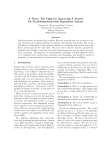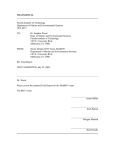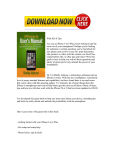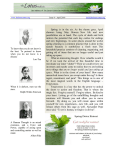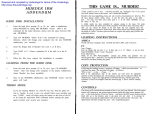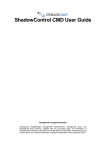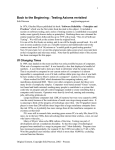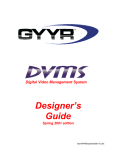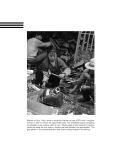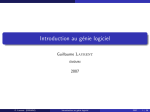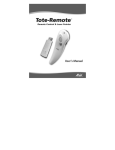Download Wiley Distinctive Design: A Practical Guide to a Useful, Beautiful Web
Transcript
D TE GH RI PY CO RI TE MA AL 1 The Distinction of Web Design Principles and variables of a visually appealing layout 4 D I S T I N C T I V E D E S I G N CREATING THE IDEAL, aesthetically pleasing, distinctive design seems like an impossible task to many. While most web industry fields have their own methodology to improve and yield results in the layout and the structure of the content, a few basic defining concepts underpin the whole process of forging beautiful designs. Essentially, the goal is to achieve maximum impact on users. Within this first chapter, I highlight the justifications for creating a distinctive design, the variables affecting the end users, and the importance of visibility. In addition, I provide a solid introduction to critical basic design concepts, including neutrality or balance. I also explain how to emphasize the right content, how to prioritize and analyze content in order to clean up an interface (using tools like minimalism), and how to avoid conflict and inconsistencies with websites. Taking You Back to Basics Within the realm of user experience, complexity has become the enemy of the people. Often at the most basic level, the need to create more intrinsically dynamic and functional designs causes website visitation (and the users who browse those sites) to suffer. Although the concept of “designing with purpose” is nothing new, how people read and recognize objects, and how much attention people give to some components within a layout compared to others, can be summed up in the four words shown in Figure 1-1. Figure -: Each and every element asks, “Can you see me?” Treating the elements of your website like a living, breathing entity may seem rather silly at first, but the visualization it produces accurately reflects the situation. Just picture CHAPTER ONE THE DISTINCTION OF WEB DESIGN 5 each part of your site as someone within a crowd. The loudest individuals are shouting above everyone else. This clashing certainly results in quieter voices going unnoticed, even if that voice is important within the project’s context. Gauging every object’s importance against the level of noise and distraction elsewhere on the page is central to assigning a level of purposeful distinction to your pages. Your users have a limited attention span, and by ensuring that the objects on the page have a wellbalanced proportion of importance versus voice, you create a distinctive—and visible— design that people can enjoy and browse without constraint. Tip To learn more about the average Internet user’s attention span (or lack thereof), check out this article by usability specialist Jakob Nielsen: www.useit.com/ alertbox/timeframes.html If something is visibly useful to a page, assign more attention to it (see Figure 1-2). Less important items on a page require less attention. You have little time to impress visitors before they hit the Back button or look elsewhere. The exact amount of time is up for debate, ranging from zero points of a second, as people subconsciously pre-judge what they see, to five or ten seconds. Web professionals often forget that selective emphasis holds importance! Figure -: A stylistic flourish within a page often depicts emphasis and strength. The balancing act can be quite tricky. You should analyze and self-critique your methods as well as ask others to give feedback. Even negative feedback is helpful; actually, in many cases, it’s more helpful than positive feedback. The justification for many design choices rests upon those four essential words (refer to Figure 1-1); by wielding such control over a page, you ensure users find what they want (or need) at the point they require it. 6 D I S T I N C T I V E D E S I G N Important Remember that feedback is quite subjective (and should be taken with a grain of salt). Don’t implement changes that users request on a whim without a good reason. Some things can actually make a design worse, and the last thing you want to do is destroy all your hard work! Time, space, and relativity Understanding the needs of your content is central to the concept of distinctive design, but the user experience demands more than simple information visibility. Although an inanimate object, your content has a few primary needs that must be accounted for in the overall layout, such as visibility and accessibility. Many variables can affect the duration and extent of a visitor’s experience, and while some of these are more imposing than others, such as pesky browser bugs and page availability, some can be tied into human perceptions and the amount of resources or self-sacrifice web professionals choose to assign to a service. Time, space, relativity, and other variables speak volumes to the finite resources humans often temporarily assign to a site for the duration of their stay. Each variable ties deeply into the other because they are often measured upon the perception of whether the effort exerted by visitors matches the importance level of other events going on around them. Check out this list of finite resources: > Time: There’s only 24 hours in a day, and users rarely spend all of those browsing a single site. How much of this precious resource a visitor uses on your site depends on the value of the content. > Space: The freedom to browse a site without inhibition is important to the overall user experience. If users feel restricted or forced into jumping through unnecessary hoops, they may exit! > Relativity: The relationship between content and sites is important to the web. If a site’s content connects to a concept or subject introduced by another site, it may gain added attention. > Money: Services with defined costs have to work even harder than free or adsupported sites for attention. Since the content is provided behind a “paywall”, money is needed to gain visibility. CHAPTER ONE THE DISTINCTION OF WEB DESIGN 7 > Patience: The average visitor feels a great variety of emotions when browsing a site (some of which you can manipulate). If barriers to entry are high, the willingness to continue may be lost. > Attention: Objects on a page are always vying for a user’s focus, and in polar opposition, users are themselves trying to get the attention they require from objects. This must be accounted for. > Loyalty: By providing good experiences and reducing the levels of background noise, users are more likely to return to our sites. > Trust: Use of a site is based on the value of its content and how reliable users deem its source. If your content is full of lies or inaccuracies, the content’s value is lowered. > Energy: Users are expected to undertake so many activities within a page. Clicking, typing, and perhaps even more! Tiredness can work as an inhibitor when browsing the web. Don’t make users exert themselves. These end-user functions (rather than controls of an interface) are subjective to every individual, but this doesn’t mean that they can’t be accounted for or measured. Don’t assume, for example, that visitors can (or want) to spend hours looking over a 5,000-page site filled with content. (Admit it: You’d lose your sanity if you had to scroll through them, so why would you torture someone else with such a process?) The balance between distinction and the variables mentioned earlier is important to get right; the two relate quite heavily to each other. Tip Making a website fun and engaging is among the best methods of distorting the time field of an end-user. People regularly waste endless hours playing games on the web, and if you are a creative individual, you can provide that sort of experience (and functionality) on your own site! Albert Einstein once said, “Put your hand on a hot stove for a minute, and it seems like an hour. Sit with a pretty girl for an hour, and it seems like a minute. THAT’S relativity”. Einstein’s quote is a perfect reminder that a user’s experience should not be painful or unendurable to the point of feeling abandoned. A visitor shouldn’t feel useless in her quest for information. More importantly, it also shows that you can manipulate the 8 D I S T I N C T I V E D E S I G N variables that people use to measure your work’s value (such as time and trust) and affect the impact upon a user (see Figure 1-3 for an example). Figure -: Straightforward forms are much less time-intensive than complex documents. Distinctive design influences the time it takes to locate important details within a page. It also sets the tone for how tedious or enjoyable finding that information is (and by association causes relativity to take effect). Understanding the connection between the actual amount of time visitors devote to your site and the perception of time they devote to your site provides you a rare opportunity to stand out, which, in turn, gives visitors the desire to return. Consider the amount of time you spend playing a game in comparison to undertaking a job you don’t find particularly enjoyable. As you spend time doing something you enjoy, the focus you place on time spent is reduced, much like the famous saying “time flies when you’re having fun.” The “time flies” ideology (known as “Tempus Fugit”) is a classic example of how variables can be manipulated to encourage continued use. Information must be visible within the confinements of the page it’s held in, or else the distinctive focus that may be drawn simply cannot exist. If you create a page that includes content or features with low visibility, (like creating elements that inadvertently minimize other elements’ importance or you intentionally apply a negative emphasis to certain content or features), the content lacking visibility inherently diminishes in importance in the end-user’s experience and could result in users missing the message. CHAPTER ONE THE DISTINCTION OF WEB DESIGN 9 Defining the ideal perspective Of the variables and principles that impact your capability to serve visitors effectively, the most common failures occur as a result of either obtrusive subjectivity (doing what you think is best for the end-user rather than what actually may be the case) or a lack of attention to detail. Appealing to the widest possible audience is critical to underpinning a distinctive design. The concept of a best-case scenario puts forth the idea that if you aim to design in ways that will generally apply to all users, you reduce the chance of confusion. Distinction isn’t about just standing out. It’s also about aesthetics and providing a visual appeal to match the visitor’s plentiful expectations! Note Many people (excluding seasoned web professionals) confuse professionalism with the visuals or aesthetic a website provides. The public associates quality products with quality layouts! Unfortunately, spammers and scammers regularly exploit this assumption by creating slick designs. A beautiful website engages more visitors, and an unattractive website gives off the impression of unprofessionalism, making users turn away as a result. Distinctive design showcases and attempts to reflect the need for a balance between beauty, usability, and awareness within the pages’ unique layout. The immediate beauty of a page (just like human attraction) is great for the short term, but substance over style and the attributes that make your site great and unique are critical to a long and happy visitor relationship. This may seem worrisome to some people, who may feel that trying to make something beautiful, unique, distinctive, and usable—all in one package—is close to impossible. It’s actually easier to make a beautiful website once you know how (Figure 1-4 gives us a quick three-step process). If you build a website that is usable, the content’s identity will be visible to those who read your copy. If your content portrays your site with depth and richness, viewers can identify with these characteristics. And if your site is distinctive, the uniqueness and aesthetic identity can be formed around it. Like with most things in life, it’s a case of everything in moderation! Granted, this is a best-case scenario, and there may be times when you may think that no perfect solution exists (perhaps one good solution has not yet been innovated), but you can compromise those ideals to a certain extent, as long as the final effect nets you the intended response. Perfection isn’t possible in design (several factors cause a lack of control over the rendering canvas), but that doesn’t mean you can’t keep improving things to reflect the experience as optimally as possible (even though the web isn’t print). 10 D I S T I N C T I V E D E S I G N Figure -: Building a distinctive and beautiful website is simpler than it may appear. Designing with Neutrality Beyond the variables I have previously mentioned relating to distinctive design and the idealistic intentions they naturally seem to evoke in giving your visitors everything (with as few consequences as possible!), the principles of how distinction is formed relate to a range of certain design concepts that exist not only within the context of the web, but also within the scope of print design. Of course, digital media and traditional print are quite different in their capabilities and limitations, but some useful lessons can be drawn from the study of concepts that branch both disciplines. One of the biggest variables that influence distinctive design (and the print world alike) is the concept of neutrality (and the Zen-like state it produces). As you’re still balancing within the realms of theory rather than practice, it may seem surprising that neutralizing visible elements of the page (and making them less visible or attention-seeking) plays a part in achieving distinction. But if you think about it, without balance, chaos reigns supreme! Thinking of your website in a Zen-like format helps you understand that to ensure a clear and enlightened perception (both in giving accurate knowledge and being easy to follow) you need to self-reflect upon the issue at hand. As a designer, you need to analyze the choices you make for the benefit of your visitors, and you also need to provide a clear method of showcasing wisdom through careful planning and resourcefulness. The principles of a Zen-like design are: > Keep the components of your site’s visibility in balance. > Consider your options wisely before you apply them. CHAPTER ONE THE DISTINCTION OF WEB DESIGN 11 > Keep your visitors enlightened (offer them knowledge). > Maintain clarity and reduce noise pollution. Implementing the Zen concept within distinctive design and following the ideals of a neutral interface is relatively straightforward. Designs composed of well-balanced content (in which the required distinctive features take precedence over less useful information) allow you to draw focus to the parts of a page that require attention. Reducing noise pollution on a page and giving that balance where it’s required keeps distinctive content— well—distinctive and lets the rest be calm, silent material that remains on the page but is noticed only as further page inspections occur. Beautiful balance Taking the concept of Zen neutrality beyond what was previously mentioned, a design that is clear in its separation of distinctive design elements from additional flourishes or extended attributes, gives your design added stability. The elements of your website are weighted (much like those in Figure 1-5) with distinctive elements holding more natural weight and value on one side and the other content balanced on the other. If the level of distinction either equals or extends beyond the neutral (less unique) content, the power of its influence lessens. Figure -: Although the balance may be offset, the need to complement such elements remains critical. When looking at existing layouts, an unnatural balance must exist between a design and the emphasis (unique components) within a page. And just like Earth, if something is thrown seriously out of whack, it seems to naturally correct itself by reducing the strength of emphasis in which attention-seeking content retains. On a page with paragraphs of text and a single heading, that heading’s distinctive nature stands away from the page 12 D I S T I N C T I V E D E S I G N (yet, if the page includes several headings, none stands out). This is due to how humans are naturally attracted to uncommon sights. Gaining a user’s eye requires a clever mix of eye candy and offsetting the layouts equilibrium. If all of your content has little to no emphasis (such as just paragraphs of text), the readability of that content is diluted to a neutral level. Yet, if you have too much emphasis (such as stuffing everything into headings like in Figure 1-6), the strength you intend to attain dilutes itself! Only when the critical mass is reached will emphasis and strength sustain itself. Figure -: If you place emphasis everywhere, nothing stands out. Before leaving the concept of balance (for the moment), it’s important to highlight the value of eliminating or repositioning balance whenever possible. The key to gaining a visitor’s attention is to provide distinctive content, but neutrality is the direct opposite of this. The trick to good design is to provide as much distinction as you can, without pushing it too far (and diluting the effect). You can apply distinction in many ways, including use of color, whitespace, and more! What this means is that if you’re smart enough to apply emphasis equally through various means, rather than on one aesthetic point, you make your content distinctive without risking the issue of over-dilution. Generally, dilution only occurs visually with a lack of context within its implementation, not just as a result of an abundance of balanced objects. CHAPTER ONE THE DISTINCTION OF WEB DESIGN 13 Emphasizing the essentials If you’ve been coding with HTML for a while or have any experience with producing websites, you should already know that certain HTML elements provided within the W3C specifications, such as strong and em, provide visual emphasis not just on the screen within the browser window (with default styles that can be overwritten) but in context within the content itself. Tip For those without coding experience, HTML stands for Hypertext Markup Language. It is the primary language web designers use to structure content within a page. Think of it as the candy wrapper that holds the goodness in pretty, identifiable containers (if they are labeled correctly)! Taking the principle of emphasis beyond the context and restraints of the HTML language, providing a flourish or distinctive marker helps users recognize a point of importance. You can emphasize a particular element in a number of ways, as long as it stands out from its surroundings. Because emphasis remains at its strongest when it stands with fewer competitors for attention, give only essential content this critical boost in visibility. Used sparingly and appropriately, emphasis can draw attention quite quickly. Some methods of providing distinction are quite direct and in-your-face; other methods can be quite subtle. While subtle methods take longer to be recognized, it’s quite likely that they are more reliable. The proliferation of advertising that fights for people’s attention illustrates this theory, because people tend to develop a level of “immunity” to patterns they recognize as negative (users automatically mentally block out blatant advertisements). See Figure 1-7. Figure -: An advertisement like this won’t hold your attention if you know it’s trying to sell something. 14 D I S T I N C T I V E D E S I G N One of the principles maintained through this book is that content must be emphasized tastefully, with serious consideration about how your visitors may be affected by the increased level of awareness to one item (against the lessened awareness of other content). Remember that balance affects your content and the value it inherits. Your goal is to ensure that viewers regard the obvious material on a page as useful, not as a blatant spam attempt. Important Opinions may vary on the extent you can emphasize content, but it’s recommended that unless you know what you’re doing, avoid forced actions such as pop-up windows, protection scripts (like anti-right-clickers), and the ever-annoying automatic music-playing jukeboxes. Negotiating neutrality When you remove emphasis from a page, what remains will increase in strength. Using neutrality effectively is an inspired concept, isn’t it? In many ways it’s like a talent contest. When fewer people enter, it’s much easier to identify the most talented individuals, but as the numbers increase designers rely more on comparison and elimination (perhaps unjustly) to give ourselves the best chance of finding the stars amongst the masses. Focusing on what’s on the page and what already has emphasis is easy (because attention grabbing is what it intends to do). But the capability to disinherit and demote enhancements and flourishes (while involving some difficult choices) can both reduce the level of noise that exists within an interface and bring some stability to the page (Figure 1-8 highlights how attention is spread). The more neutrality you assign, the more direct the effects are upon content that retains its status and levels of importance. If you already have a website, strip away all of the excess, both graphically and contextually (from existing emphasis). Once your content sits on an unstyled and visibly similar page, it becomes easier to see when you have an excess of information, thereby making your distinctive content harder for the reader to identify. This action could encourage you to apply emphasis more intelligently or with greater constraint. By doing this you deconstruct the aesthetic using reductionism (a principle examined later in this chapter). Important Whenever you change your source code (or critical files like images), make a backup or use a version control system just in case you need to return to the older edition later! It’s common sense to safeguard your work, especially if you’re making potentially dramatic changes to it. CHAPTER ONE THE DISTINCTION OF WEB DESIGN 15 Figure -: Balancing a page using less-emphasized content (of various types) redirects attention. So far, you have seen the benefits of becoming Zen-like in your design approach by redrawing the balance when you feel it can improve the way information is conveyed, and by balancing neutrality and emphasis, which reflects the opposing sides of attentionfocusing. In the next section, I go over the more straightforward principle of simplicity. It is one of the most primal methodological forces for improving the distinction of what remains visible on-screen (and without it, things would get very cluttered indeed). The Sum of All Parts Holding your visitor’s attention with plenty of active elements on a page can be difficult. Because distractions on a page can reduce the visibility of key information, it’s important to preserve the integrity of the emphasized content that already exists. If adding emphasis to such content seems like the only answer to your problems, never fear; there is a less popular but equally powerful way to give a cluster of content emphasis. That method is to take away any unnecessary clutter from the website’s foreground and background (think of it as spring cleaning for your visitor’s benefit). Note For every element, property, and function, keep asking if what’s sitting within your pages is really necessary. If you can’t justify it, remove it entirely! Or if you need to include it on the page, you can progressively disclose it as required (making it visible only when it’s needed onscreen). 16 D I S T I N C T I V E D E S I G N With increasing techniques to provide content on demand, the capability to perform such a function has become more widespread and popular. A website is essentially the composition of its many parts joining together in harmony. Distinctive designers need to reduce information overload and simplify the overall experience. Luckily for us, the web is evolving rapidly in ways that are helping you to achieve the design goals you set ourselves. Perhaps because of its implications in search engine optimization or the assumption that more is better, removing emphasis (thereby stating some content is less important) or objects from the page can be quite a scary prospect. Simplifying the interface and maximizing the use of the space is critical to reduce unnecessary content removal. Instead of purging the material entirely, you can hide the content until necessary. Methods that give content on demand a fresh appeal include: > CSS3 selectors (like target or checked) > JavaScript and JS libraries (like jQuery) > AJAX (which has wide browser support) An interface with fewer components inherently has fewer elements fighting for space and visual recognition. Such an interface also encourages visitors to read the full page rather than scan it. Don’t be afraid to use some of the effective tools in the modern designer’s toolkit—simplifying the interface, reducing content (or emphasizing the content’s value in more efficient ways), clearing out any unhelpful or boring content, and heuristically assigning value (thereby temporarily hiding less valuable assets). Tip For those without coding experience, CSS stands for Cascading Style Sheets and represents the visual style. JavaScript is used to control behavior-based events, and AJAX is a method of processing data between a user and the host’s machine. All three can help you avoid page refreshes and provide a seamless, content-packed experience! Beautiful emptiness Picture an empty website void of content, graphics, color, and every other asset of emphasis and distinction you can include. This emptiness may seem boring, but it actually showcases one of the most primal and fundamental aspects of design. Emptiness and space can be beautiful (see Figure 1-9 for a lovely example of how an empty space could appear). Such a visual representation is the epiphany of balance and a Zen state of being. If anything were to be added to it, the distinction would be at its strongest. CHAPTER ONE THE DISTINCTION OF WEB DESIGN 17 Figure -: This is one of the cleanest environments known to man . . . a blank website. Obviously, as a web designer, you are required to include content or items of interest for the visitor, and this coincidently means the addition of material to your once derelict yet simplified blank page. Clean can be very beautiful, but context and richness have more value! One beautiful example of simplicity in effect is the www.madebysofa.com site, which shows that combining quality content with a basic layout can still be rich in distinction. Individuals building a website from the ground up, in which nothing is set in stone, should take time to examine not only what options are available to provide emphasis where it’s needed, but also to refrain from applying stylistic, graphical, structural, or behavioral emphasis and distinction within the web page unless absolutely sure. If you can get away with simpler, it may work to your users’ benefit. Individuals adapting an existing site to make it more distinctive (and perhaps more valuable to the visitor) should consider reformatting all of the content back to a neutral state like plain text. Otherwise, you can simply examine the various individual components of your site and decide on individual changes as needed. How you choose to transform the emptiness or existing construction into an elegant and optimized environment is up to you. (Figure 1-10 shows a basic example of how a more technical interface can be simplified.) What is great about distinctive design is that you can implement it progressively over a period of time, or you can use it as a basis for a design built from the ground up. The result of your work will be an interface that benefits more users. 18 D I S T I N C T I V E D E S I G N Figure -: Progressively enhancing or gracefully degrading, both are great design philosophies. Sanitizing the interface Four primary methods accurately depict how to remove content that is otherwise deemed unnecessary from an interface in order to better portray the content that already exists. Although each tends to come with a varying set of definitions (as everyone seems to have a different interpretation of its meaning), they all play an essential role in design. Figure 1-11 identifies the bond each has to the design process. Figure -: The four cornerstones of distinctive cleaning. If it isn’t needed, it should disappear! Simplicity Simplicity is one of the most fundamental aspects of a clean and efficient user experience. The acronyms KISS (“Keep it simple, stupid!”) and YAGNI (“You ain’t gonna need it”) explain this principle in a highly direct method. Making things overly complex irritates users, and unless you genuinely need a function or a visual representation in the CHAPTER ONE THE DISTINCTION OF WEB DESIGN 19 interface, don’t add it. If there is a way to achieve something on the page with fewer objects, elements or visual points of interest, it’s worth doing, as the likelihood for distraction will be minimized. Minimalism Minimalism is a method that encourages simplicity by preventing the enhancement of elements until it is required. It is about taking something of existing complexity (like an existing site) and stripping away every element that doesn’t need to be complex. This concept aims to deconstruct and improve the site with fewer or an equal number of features of the same complexity level. With simplicity, you aim to strip existing objects down into their core components. In minimalism, you start with only what’s necessary and build upon that (when improvement is demanded). Reductionism Reductionism follows a more scientific process than the previous two; it is the idea that if something complex is taken and reduced to its most fundamental parts, you can better understand its nature. Within the scope of distinctive design, you find that if you investigate how particular parts of a site function, you can determine where emphasis may occur. From there, you learn to improve the object. As an example, take the search engine results page. Consider where your eyes are naturally drawn. Decide if that’s where you would like your visitor to look or if it should be changed. Holism Finally, it’s worth noting the holistic approach, which acts in opposition to reductionist theories (within design). Aristotle said that “the whole is more than the sum of its parts,” and within the concept of design, this often holds true. Although you can reduce a site down to a basic level to understand how things function, you need to visualize those parts in context of the whole page. Never just assume that making a site simpler or smarter will resolve every problem, because some issues result from outside influences that are difficult to measure. This effect is magnified on the web. Tip When assigning a level of importance to the components of your website, separate text from images and other forms of media (providing their distinction levels) because the level of emphasis a video and other input mediums (like audio) endure are far greater than what text provides. 20 D I S T I N C T I V E D E S I G N Being Consistent is Critical Consistency is an important aspect of a web interface. With regard to your visitors and audience, learning new things can be a particularly scary idea if they are forced to use trial and error to find what they are looking for. One of the main reasons why most websites don’t have a totally different look for every page is that visitors need to effectively navigate around a page without getting lost (imagine the learning curve if every page is visually different). Visitors often scan a page to proactively seek what they are interested in (rather than reading a page in full, as shown in Figure 1-12). They are more likely to use a mixture of guesswork and quick responsive selections to find the closest match to their needs. If they don’t find what they’re looking for, they’ll return to the original starting page to try again. They are even more inclined to guesswork in an attempt to speed up the results. Although this erratic style of behavior may seem impossible to assist, clearly defined, well-labeled, distinctive layouts work wonders. Figure -: As your visitors scan for specific keywords, their focus ignores what doesn’t associate. If your visitors are fairly inexperienced with technology (as many Internet users are), they probably depend on conventions or trends (recognizable objects on the page like navigation menus and clickable logos) to help them navigate around a site. Major changes between designs or pages can therefore lead to widespread confusion. To quote Homer Simpson, “In times of trouble you’ve got to go with what you know.” That’s precisely what users do. If they feel something is too hard or inconsistent (and you have competition), they leave to find an easier source of information! Important Although it does not apply to everyone, the numbers of users who scan information for relevance first and read second are in the vast majority. This may be related to the reduced amount of free time people generally have (though research with exact figures is limited). CHAPTER ONE THE DISTINCTION OF WEB DESIGN 21 Part of the justification for emphasis within a website is to lead your visitors by the hand and guide them to the content that matters most to them. Titles within page sections aim to give visitors an idea of where certain data is located; images and navigation menus help visitors get to a resource they require; and even conventions like the underlined link (as shown in Figure 1-13) helps visitors establish whether they need to click or continue reading! Figure -: The default underlined link is often depicted by a selection of browser-induced trends. Distinctively barrier-free The problem of inconsistent design forces website visitors to re-evaluate everything they know about an interface, which isn’t helpful because you want to keep the process as smooth and streamlined as possible, but punishing your users by accident can also be a problem that many designers fail to account for. Overcomplicated visuals, dense or heavy content, and invasive or abusive functionality disrupt the flow and distinction. One clear example of this problem in action is the issue of repetition. As users examine the distinctive regions of your site in order to associate that location and content with a specific function (such as a navigation menu), confusion occurs if repetition exists in another format. For example, many advertisers use these techniques to fool visitors into thinking that their computers’ security may suddenly be at risk. Arguably, using existing distinctive elements may yield results from individuals who progress throughout a site without thinking, but the need for ethical practices in promoting distinction takes precedence. If you produce a distinctive page element that misguides the visitor, that user’s trust in your brand (and any other distinctive elements within the site) may be permanently damaged, thereby turning the distinction into a negative. 22 Important D I S T I N C T I V E D E S I G N On rare occasions, a distinctive design can suffer a negative impact. This is only caused when the visitor’s finite resources suffer and run dry (such as a lack of trust or loyalty to a particular brand). Avoiding such events will be straightforward if you follow any prescribed guidelines. No visitor wants to endure the frustration of trying to adapt their skill set to match your site’s requirements. Allowing a visitor to drift among the elements of your site undisturbed requires the capability to navigate around a site “brainlessly” (without thinking twice). A user’s satisfaction increases if they have few obstacles to work through, and the barrier to entry is as unobtrusive (or intrusive) as possible, so it’s worth the effort. In Figure 1-14 you can see how simple page numbering provides some sense of the site’s depth to help users make basic, yet informed, choices. Figure -: Page numbering within a blog helps visitors know how long an article might be. When a site provides barriers to entry or an inconsistent, non-transitional interface, the visitor is likely to become reliant on interpreting (usually on a whim) the exact nature or depth of the content being explored. This coping mechanism of trying to stumble on what he or she is looking for usually comes at the cost of reducing the user’s patience, making him or her feel inferior, and increasing the risk of a fast exit. Consider a popular site like Amazon. The sheer number of products acts as a barrier to entry as browsing without a product in mind could lead you into spending days stumbling around one category listing. CHAPTER ONE THE DISTINCTION OF WEB DESIGN 23 Consequences of distinction The benefits of a user-centered experience are justified within distinctive design because you ensure those who use the information on your site have access to it. With visitors often finding themselves unable to locate information that should be visible within a site, it’s important to guide users without limiting their interaction capabilities. Reference A number of aids that can assist users exist, but increasing usage scenarios make the web developer’s job harder. These range from the browsers or devices people use to the way their brains function and the tools that exist to help with certain disadvantages (like screen readers for the disabled). It’s your job to ensure that these tools work for our users. The consequences of emphasis and distinction will be felt wherever they are placed. By boosting the visibility of important content, neutralizing (or eliminating) less relevant details, and accounting for the principles that dominate your page’s appearance, you increase the readability and visitor awareness of the content you want to showcase. Although it won’t suddenly turn a poor-quality site into something amazing, it certainly goes a long way to improving it in a way that benefits your readers. Summary The beginning of this chapter examines the slogan that depicts the need for elements to have attention so that users recognize them. “Can you see me?” speaks to them on behalf of your site, so if the answer is no (and it’s the data your visitors are looking for), something is amok and needs immediate attention! These principles are fundamental to a site’s capability to showcase distinction and empathy toward the visitor’s needs. Visitors devote a finite amount of resources (such as time and trust) to you on a temporary basis during their stay. A distinctive design should not only look and feel better, it should feel effortless, obvious, and self-explanatory. Plus, because there’s little additional work involved, there is no valid excuse against making your visitors happier and more comfortable with your user interface.






















